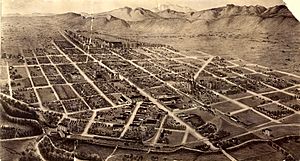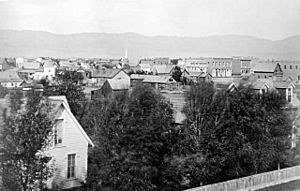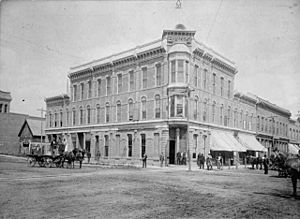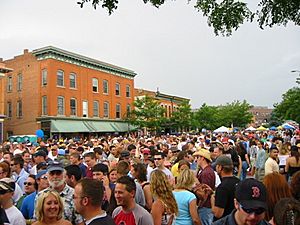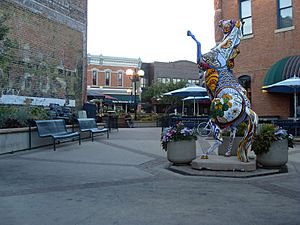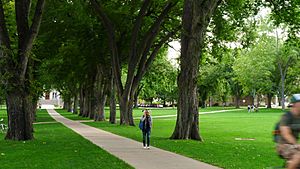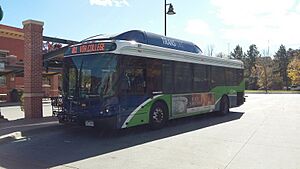Fort Collins, Colorado facts for kids
Quick facts for kids
Fort Collins, Colorado
|
||
|---|---|---|
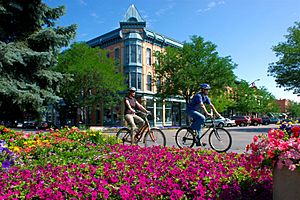
Downtown "Old Town" Fort Collins
|
||
|
||
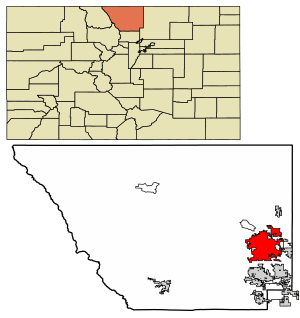
Location of Fort Collins in Larimer County, Colorado
|
||
| Country | United States | |
| State | Colorado | |
| County | Larimer County | |
| Commissioned | 1864 | |
| Incorporated | February 12, 1883 | |
| Named for | William O. Collins | |
| Government | ||
| • Type | Home rule municipality | |
| Area | ||
| • Total | 58.473 sq mi (151.444 km2) | |
| • Land | 57.212 sq mi (148.179 km2) | |
| • Water | 1.261 sq mi (3.265 km2) | |
| Elevation | 5,003 ft (1,525 m) | |
| Population
(2020)
|
||
| • Total | 169,810 | |
| • Rank | ||
| • Density | 2,968/sq mi (1,146/km2) | |
| • Urban | 326,332 (US: 123rd) | |
| • Urban density | 2,766.1/sq mi (1,068/km2) | |
| • Metro | 359,066 (US: 151st) | |
| • Front Range | 5,055,344 | |
| Time zone | UTC−07:00 (MST) | |
| • Summer (DST) | UTC−06:00 (MDT) | |
| ZIP Codes |
80521–80528
|
|
| Area code | 970 | |
| FIPS code | 08-27425 | |
| GNIS feature ID | 0204673 | |
| Highways | ||
Fort Collins is a big city in Colorado, United States. It's the main city of Larimer County and the fourth largest city in Colorado. In 2020, about 169,810 people lived here.
Fort Collins is known as a college town because it's home to Colorado State University. This is a large public research university, and it's the second biggest university in Colorado. The city is located on the Cache La Poudre River, about 56 miles (90 km) north of Denver.
Contents
History of Fort Collins
Early Days and Founding
The Northern Arapaho people lived in the Cache la Poudre River Valley, where Fort Collins is now. A leader named Friday was known for being a peacemaker between his people and white settlers. However, the Arapahos were eventually moved out of Colorado in the 1860s.
Fort Collins started as a military base for the United States Army in 1864. It was built after a flood destroyed an earlier camp called Camp Collins. This camp was set up to protect the mail route during conflicts in the mid-1860s. The new fort was named after Colonel William O. Collins of Fort Laramie. It was never a walled fort and was used by soldiers from the 11th Ohio Volunteer Cavalry.
Growth and Development
Settlers quickly moved to the area around the fort. The fort closed in 1867. The first school and church opened in 1866. The town was officially planned out in 1867. In 1868, Fort Collins became the main town of Larimer County.
The city grew a lot in 1872 when an agricultural colony was started. Many new settlers arrived. The town officially became a city in 1873. Colorado State University was founded in 1870, but classes didn't start until 1879.
In the 1880s, many beautiful homes and businesses were built. Early industries included stone quarrying, sugar-beet farming, and raising sheep. The area became known as the "Lamb feeding capital of the world" in the early 1900s. A large sugar processing plant was built nearby in Loveland in 1901.
Modern Fort Collins
Even during the Great Depression and a drought, Fort Collins kept growing slowly. After World War II, the city's population doubled, and the economy boomed. Many old buildings were replaced with new ones. The sugar factory closed in 1955.
Colorado State University grew a lot in the 1960s. It became the most important part of the city's economy. Fort Collins was once a very strict city, even banning alcohol until 1969. During this time, there were also protests for civil rights and against war.
In the late 1900s, Fort Collins expanded quickly to the south. The city also worked to improve its historic "Old Town" area. In July 1997, the city had a big flash flood when 10 to 14 inches (250 to 360 mm) of rain fell. Five people died, and there was a lot of damage to the city and the university.
Geography and Climate
Where is Fort Collins?
Fort Collins is at the bottom of the Rocky Mountain foothills. It's about 60 miles (97 km) north of Denver and 45 miles (72 km) south of Cheyenne, Wyoming. The city is about 4,982 feet (1,519 meters) above sea level.
Important natural spots include Horsetooth Reservoir and Horsetooth Mountain. Horsetooth Mountain is named for a tooth-shaped rock that you can see from the city. On a clear day, you can also see Longs Peak to the southwest. The Cache La Poudre River and Spring Creek flow through the city.
Fort Collins covers about 58.47 square miles (151.444 km2). About 1.26 square miles (3.265 km2) of this is water.
What is the Weather Like?
Fort Collins has a cold semi-arid climate. This means it has warm to hot summers and long, moderately cold winters. Sometimes, warm winds can make winters feel milder.
- The average temperature in December, the coldest month, is 31.1°F (-0.5°C).
- It snows about 51.4 inches (1.31 m) each year. Snow can fall from early September to late May.
- The city gets about 15.88 inches (403 mm) of rain each year.
| Climate data for Fort Collins, Colorado, 1991–2020 normals, extremes 1893–present | |||||||||||||
|---|---|---|---|---|---|---|---|---|---|---|---|---|---|
| Month | Jan | Feb | Mar | Apr | May | Jun | Jul | Aug | Sep | Oct | Nov | Dec | Year |
| Record high °F (°C) | 75 (24) |
77 (25) |
81 (27) |
89 (32) |
97 (36) |
102 (39) |
103 (39) |
100 (38) |
99 (37) |
88 (31) |
81 (27) |
76 (24) |
103 (39) |
| Mean maximum °F (°C) | 63.6 (17.6) |
65.9 (18.8) |
73.9 (23.3) |
80.2 (26.8) |
87.3 (30.7) |
94.5 (34.7) |
97.4 (36.3) |
95.1 (35.1) |
91.2 (32.9) |
82.3 (27.9) |
72 (22) |
62.7 (17.1) |
98.2 (36.8) |
| Mean daily maximum °F (°C) | 45 (7) |
46.8 (8.2) |
56.4 (13.6) |
62.5 (16.9) |
70.9 (21.6) |
81.8 (27.7) |
87.4 (30.8) |
85 (29) |
77.4 (25.2) |
64.3 (17.9) |
52.5 (11.4) |
44 (7) |
64.5 (18.0) |
| Daily mean °F (°C) | 31.6 (−0.2) |
33.8 (1.0) |
42.4 (5.8) |
49 (9) |
57.5 (14.2) |
67.3 (19.6) |
73.1 (22.8) |
70.7 (21.5) |
62.7 (17.1) |
50.2 (10.1) |
39.3 (4.1) |
31.1 (−0.5) |
50.7 (10.4) |
| Mean daily minimum °F (°C) | 18.3 (−7.6) |
20.7 (−6.3) |
28.5 (−1.9) |
35.4 (1.9) |
44.1 (6.7) |
52.8 (11.6) |
58.7 (14.8) |
56.5 (13.6) |
48 (9) |
36.1 (2.3) |
26.1 (−3.3) |
18.3 (−7.6) |
37.0 (2.8) |
| Mean minimum °F (°C) | −1.9 (−18.8) |
1.6 (−16.9) |
10.9 (−11.7) |
21.8 (−5.7) |
31.1 (−0.5) |
42.8 (6.0) |
51.6 (10.9) |
48.3 (9.1) |
34.8 (1.6) |
19.4 (−7.0) |
7.7 (−13.5) |
−0.2 (−17.9) |
−7.7 (−22.1) |
| Record low °F (°C) | −38 (−39) |
−41 (−41) |
−31 (−35) |
−10 (−23) |
12 (−11) |
29 (−2) |
36 (2) |
32 (0) |
18 (−8) |
−8 (−22) |
−21 (−29) |
−35 (−37) |
−41 (−41) |
| Average precipitation inches (mm) | 0.41 (10) |
0.47 (12) |
1.31 (33) |
2.10 (53) |
2.72 (69) |
1.90 (48) |
1.63 (41) |
1.45 (37) |
1.43 (36) |
1.25 (32) |
0.74 (19) |
0.47 (12) |
15.88 (402) |
| Average snowfall inches (cm) | 6.7 (17) |
7.6 (19) |
9.4 (24) |
6.2 (16) |
1.6 (4.1) |
0 (0) |
0 (0) |
0 (0) |
0.7 (1.8) |
4.1 (10) |
7.6 (19) |
7.5 (19) |
51.4 (129.9) |
| Average precipitation days (≥ 0.01 in) | 3.9 | 5.1 | 6 | 9 | 12 | 9.4 | 9.4 | 8.8 | 7.2 | 6.2 | 4.8 | 4.1 | 85.9 |
| Average snowy days (≥ 0.1 in) | 4.3 | 5.5 | 4.5 | 3.1 | 0.6 | 0 | 0 | 0 | 0.3 | 1.3 | 3.6 | 4.3 | 27.5 |
| Source 1: NOAA | |||||||||||||
| Source 2: National Weather Service | |||||||||||||
People of Fort Collins
| Historical population | |||
|---|---|---|---|
| Census | Pop. | %± | |
| 1880 | 1,356 | — | |
| 1890 | 2,011 | 48.3% | |
| 1900 | 3,053 | 51.8% | |
| 1910 | 8,210 | 168.9% | |
| 1920 | 8,755 | 6.6% | |
| 1930 | 11,489 | 31.2% | |
| 1940 | 12,251 | 6.6% | |
| 1950 | 14,937 | 21.9% | |
| 1960 | 25,027 | 67.6% | |
| 1970 | 43,337 | 73.2% | |
| 1980 | 65,092 | 50.2% | |
| 1990 | 87,758 | 34.8% | |
| 2000 | 118,652 | 35.2% | |
| 2010 | 143,986 | 21.4% | |
| 2020 | 169,810 | 17.9% | |
| U.S. Decennial Census | |||
Fort Collins is the fourth largest city in Colorado. In 2020, its population was 169,810. The city has grown a lot over the years.
In 2000, about 82.4% of the people were White. About 3.01% were Black or African American. About 2.48% were Asian. People of Hispanic or Latino background made up about 10.79% of the population.
The city has a mix of families and individuals. In 2000, about 29% of households had children under 18. The average age in the city was 28 years old. This is because many college students live in Fort Collins.
Economy and Jobs
What Industries are in Fort Collins?
Fort Collins has a mix of different businesses. These include manufacturing and service companies. Some well-known manufacturers are Woodward Governor, Anheuser-Busch, and Otterbox.
Many high-tech companies have moved to Fort Collins. This is because of the research and resources at Colorado State University. Companies like Hewlett-Packard, Intel, and Microsoft have offices here. Other important industries are clean energy, bioscience, and agriculture technology.
Top Employers
The biggest employers in Fort Collins include:
- Colorado State University (7,800 employees)
- Poudre Valley Hospital (5,600 employees)
- Poudre R-1 School District (4,000 employees)
- Larimer County (2,040 employees)
- City of Fort Collins (2,030 employees)
- Woodward, Inc. (1,300 employees)
- Broadcom Inc. (1,260 employees)
- Colorado Department of Agriculture (1,120 employees)
- King Soopers (870 employees)
- Otter Products, LLC (820 employees)
Brewing Industry
Fort Collins is famous for its breweries. There are over 20 breweries in the city. Some popular ones are Anheuser-Busch, New Belgium Brewing Company, and Odell Brewing Company. In 2010, the brewing industry brought in over $300 million and created many jobs in the area.
Sustainability Efforts
Fort Collins has worked on projects to be more sustainable. One project was FortZED, which aimed to make the downtown area and Colorado State University campus use energy more efficiently. It used smart technology and renewable energy. This program helped manage how energy was used and supplied. It ended in 2017 after many of its goals were met.
Arts and Fun Activities
Fort Collins has a lively culture, especially because of its many college students. There's a local music scene and many craft breweries. The Downtown Business Association hosts festivals each year in the historic Downtown area.
- The Fort Collins Lincoln Center is where the Fort Collins Symphony Orchestra performs. It also hosts Broadway shows.
- The Colorado Brewers Festival is held every June. It features beers from many Colorado brewers and attracts about 30,000 people.
- New Belgium Brewing Company hosts the Tour de Fat, a bike parade where people dress in costumes.
- The Colorado Marathon and FORTitude 10K are popular running events.
The Fort Collins Museum teaches about the history and culture of the area. It has over 30,000 artifacts and historical buildings. The city also has art galleries and a theater company.
Parks and Outdoor Recreation
Fort Collins has many beautiful parks and outdoor spaces.
- The Gardens on Spring Creek is an 18-acre (7.3 ha) botanical garden. It has different themed gardens, including a children's garden.
- There are 875 acres (354 ha) of developed park areas. These parks have tennis courts, frisbee golf courses, golf courses, dog parks, baseball fields, and picnic areas.
- Some major parks include City Park, Edora Park, and Spring Canyon Park.
- Fort Collins also has a whitewater park along the Poudre River.
- The city bought the Soapstone Prairie Natural Area, a large park and conservation area north of the city. It includes the Lindenmeier site, an important archaeological site.
Education in Fort Collins
K-12 Schools
Public schools in Fort Collins are part of the Poudre School District (PSD). This district also serves nearby towns like Wellington and Timnath. It's one of the fastest-growing school districts in Northern Colorado.
PSD has four main high schools:
- Fort Collins High School
- Rocky Mountain High School
- Poudre High School
- Fossil Ridge High School
There are also alternative high schools and public charter schools like Ridgeview Classical Schools. The district has ten middle schools and 32 elementary schools.
Private schools in Fort Collins include Heritage Christian Academy and St. Joseph's Catholic School.
Public Libraries
The Poudre River Public Library District has three libraries in Fort Collins: Old Town, Harmony, and Council Tree. This library system serves over 207,000 people.
- The Old Town Library is 43,000 square feet and opened in 1976.
- The Harmony Library is a joint library with Front Range Community College.
- The Council Tree Library is smaller and focuses on families with young children.
The first public reading rooms in Fort Collins started in the late 1800s. The Fort Collins Public Library officially opened in 1900. It received money from Andrew Carnegie to build its first building, which opened in 1904. In 2006, residents voted to create the Poudre River Public Library District to better fund and manage the libraries.
Colleges and Universities
Colorado State University is the main university in Fort Collins. Front Range Community College also has a campus in the city. It offers two-year degrees and vocational programs.
Fort Collins is home to several research institutes. These include facilities for the Centers for Disease Control and Prevention and the U.S. Forest Service.
Getting Around Fort Collins
Roads and Highways
Fort Collins has a grid of streets downtown. Interstate 25 runs north and south on the east side of the city. U.S. Highway 287 becomes College Avenue inside the city and is a very busy street.
Public Transportation
- Trolley: Fort Collins used to have a trolley service that ran from 1907 to 1951. A part of the line and one of the original trolley cars were restored in 1984. Now, the Fort Collins Municipal Railway operates as a heritage trolley on weekends and holidays for tourists.
- Buses: The city's bus system is called Transfort. It runs many routes throughout Fort Collins.
- MAX Bus Rapid Transit: The MAX Bus Rapid Transit is a special bus service that runs along the Mason Corridor. It connects Downtown Fort Collins to the south side of the city. It started in 2014 and is meant to help future city development.
- Regional Buses: Fort Collins is connected to other nearby cities like Loveland and Boulder by the FLEX bus route. The Poudre Express connects Fort Collins to Windsor and Greeley.
- Intercity Buses: Bustang provides bus service connecting Fort Collins to Denver and other cities in Colorado.
Cycling
Biking is a very popular way to get around Fort Collins.
- There are over 280 miles (450 km) of bike paths and lanes. This includes paved trails like the Spring Creek and Poudre River Trails.
- The Fort Collins Bicycle Library lets visitors and residents borrow bikes. They even have self-guided tours like a Brewery Tour and a Historic Tour.
- In 2013, Fort Collins was named a Platinum-level Bicycle Friendly Community, one of the best in the U.S. In 2018, it was ranked the number one city in the United States for cycling.
Electric Scooters
In 2019, Fort Collins started a pilot program for electric scooter sharing with the Bird company. The city has rules for where scooters can be parked and ridden.
Important Places and Services
- NIST time signal transmitters WWV and WWVB are located near the city.
- Poudre Valley Hospital is a major healthcare center for the region.
- The National Center for Genetic Resources Preservation (NCGRP) is located here.
- Fort Collins is the main office for Roosevelt National Forest.
- The Centers for Disease Control and Prevention has a division here.
- The National Wildlife Research Center is also in Fort Collins.
Police Services
The Fort Collins Police Services is led by Chief Jeffrey Swoboda. In 2018, it had 214 police officers and 115 civilian staff.
Famous People from Fort Collins
Many notable people have connections to Fort Collins:
- Wayne Allard, a former U.S. senator.
- John Ashton, an actor.
- Frank Caeti, a cast member on MADtv.
- Temple Grandin, a famous author and professor.
- Jon Heder, an actor known for Napoleon Dynamite.
- Jake Lloyd, the actor who played young Anakin Skywalker in Star Wars: Episode I – The Phantom Menace.
- Hattie McDaniel, the first African-American to win an Academy Award.
- Derek Vincent Smith, an electronic music artist.
- Bill Stevenson, a musician and record producer.
- Travis Lane Stork, a TV personality and doctor.
- Byron Raymond White, a former Justice of the Supreme Court.
Images for kids
See also
 In Spanish: Fort Collins (Colorado) para niños
In Spanish: Fort Collins (Colorado) para niños





